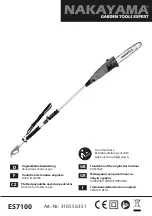
25
GB
8. Attachment and operation
Before starting the equipment
Make sure the machine stands securely, i.e. bolt it
to a workbench or solid base. There are two holes
for this purpose in the machine foot. • The saw table
must be mounted correctly.
•
All covers and safety devices have to be properly
fitted before the machine is switched on.
•
It must be possible for the blade to run freely.
•
When working with wood that has been processed
before, watch out for foreign bodies such as nails
or screws etc.
•
Before you actuate the On/Off switch, make sure
that the saw blade is correctly fitted and that the
machine’s moving parts run smoothly.
•
Before you connect the machine to the power
supply, make sure the data on the rating plate is
the same as that for your mains.
Assembly tools
1 engineer’s wrench SW 10/13
8.1 Mounting the base (Fig. 2+3)
Installation parts:
•
4 stand feet (A)
•
stand braces below (B): 2 x long + 2 x short
•
stand braces above (C): 2 x long + 2 x short
•
4 rubber feet (D), 4 washer 8, 4 nuts M8
•
Mounting parts (24 carriage bolts M8x16, 4 hex
screws M8x45, 32 washer 8, 28 nuts M8)
Hand-tighten all screws lightly during the installation.
•
Place the 4 rubber feet on the stand feet.
•
Attach one stand brace below (B) each with 2
screws M8 x 16, 2 washer and 2 nuts to the stand
feet (A).
•
Mount the frame struts above (C), each with 4 car-
riage bolts M8 x 16, 4 washers and 4 nuts on the
frame feet (A) as shown in Fig. 3.
•
Place a cardboard box behind the machine and
then carefully tip the machine backward until the
machine rests on its housing.
•
Place the previously assembled frame (Fig. 2) un-
der the base plate (E) of the band saw; screw it into
place by hand with 4 hex bolts M8x45, 8 washers,
4 circlips and 4 hex nuts. (Fig. 3)
•
Set the machine with the base on a level surface
and tighten all the screws and nuts firmly.
8.2 Assembling the work table, (Fig. 4 - 6)
•
Lay the table insert (a) in the recess in the work
table intended for this (Fig. 4). (To replace, disas-
semble the work table in reverse order.)
•
Place the band saw blade through the slot on the
machine table. Place the machine table on the ta-
ble guide so that the fixing screw (b) fits through
the bracket (c).
•
Screw the machine table tight with the wing nut
(E).
•
Check that the bandsaw blade runs freely and does
not touch the table.
•
Using the adjustment screw (F) to adjust the table
to a right-angle.
– Use a set square –
•
Counter the adjustment screw (F) and tighten the
wing nut (E).
•
Set the scale pointer (G) to 0.
•
Adjust the angle scale (I):
•
By loosening the screws (H) and shifting the angle
scale (I) until the scale pointer (G) points to 0. Fix
screws.
8.3 Assembly of the length end stop (Fig. 7+8)
•
Turn the four knurled screws (J), each with a flat
washer, roughly 5 mm into the table surface (Fig.
7)
•
Place the guidance tube so that it touches the table
and tighten the four knurled screws (J).
•
Now, put the length end stop (5) on the guidance
pipe, to the left of the saw blade, and clamp it
tightly. The end stop pipe should now be parallel
to the table groove.
8.4 Setting the number of revolutions
(Fig.10+11+11.1)
Pull the mains plug!
•
Open lower guard.
•
Release the belt with the tension handle (10).
•
Put the belt into the desired position. (L1 or L2).
•
Retension the belt with the tension handle (10).
•
Close the lower guard.
Rpm range:
Rpm stage 1 360 m/min.
For processing hardwood, materials similar to hard-
wood and for fine cuts.
Rpm stage 2 720 m/min.
For processing softwoods and for less fine cuts.
8.5 Sawblade guiding (Fig. 12)
The sawblade guiding (4) is adjusted with the fixing
button (11).
The upper sawblade guiding can be set from 0 to 175
mm work piece height.
A clearance as small as possible to the work piece
ensures an optimum sawblade guiding and safe
working.
Back pressure bearings (Fig. 13+14)
The back pressure bearings (d) accept the feed pres-
sure of the work piece. Set the upper and lower back
pressure bearing in such a way that it slightly touch-
es the sawblade back. Tighten the screws (e). The
distance should be 0.5 mm.
Upper guide rollers (Fig. 13)
Set the upper guide rollers (f) to the corresponding
sawblade width. The front edges of the guide roll-
ers must not exceed the tooth base of the sawblade.
When the guide rollers slightly touch the sawblade,
tighten the screws (e).
Summary of Contents for 5801502903
Page 2: ...2...
Page 5: ...5 11 Fig 12 Fig 13 f d f e e e Fig 14 g g d h h Fig 15 N i e e Fig 16 l j k n m m 12...
Page 6: ...Fig B Fig C Fig D 6 Fig A...
Page 54: ...54 54 R1 R2 K2 K2 K1 230V C...
Page 55: ......
Page 56: ...56...
Page 57: ......
















































